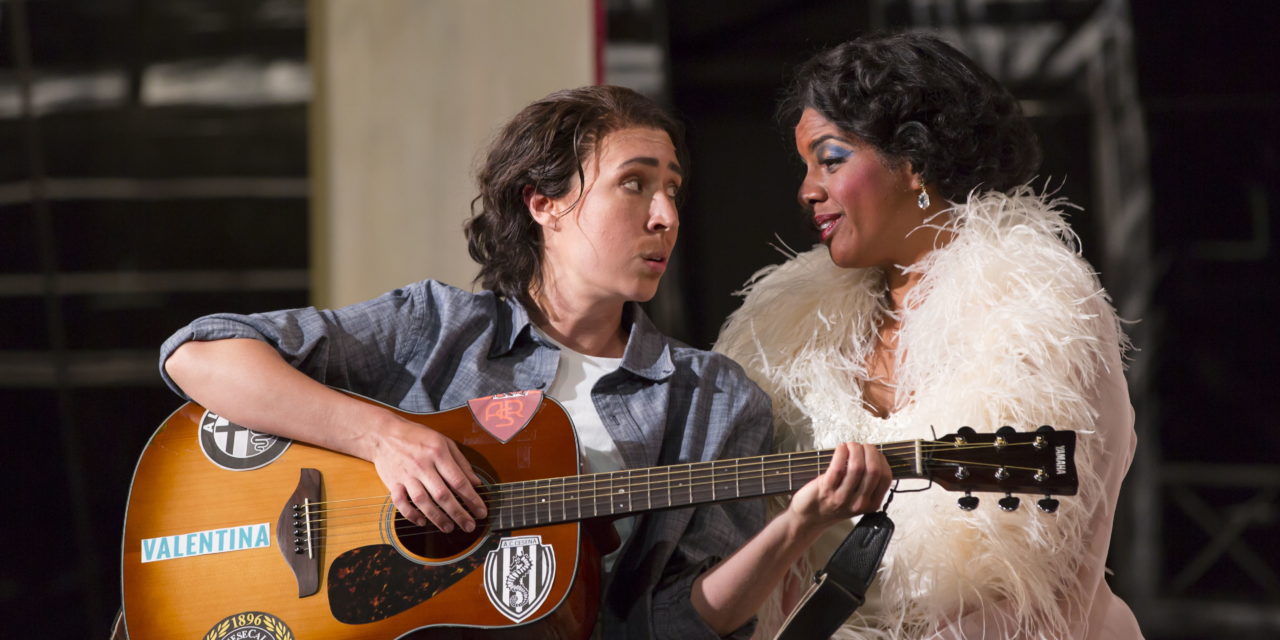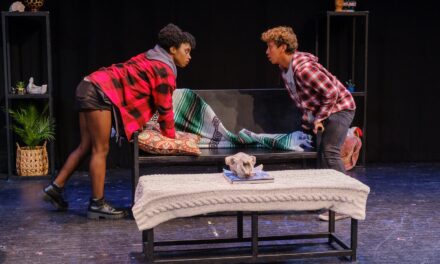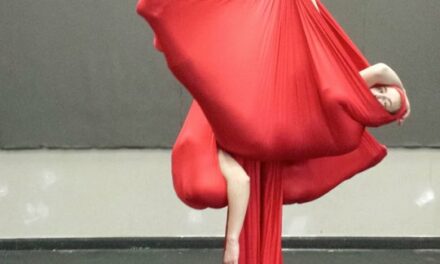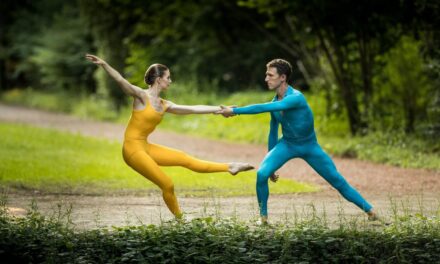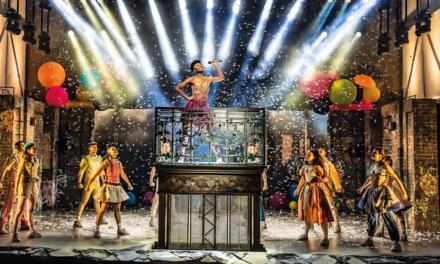Boston Lyric Opera’s The Marriage of Figaro opened on Friday to an audience that the John Hancock Hall’s lobby could barely contain and filter into the theatre. This closes out the first season in many years in which the company has not renewed its contract at the Shubert Theatre, and this is the third new venue for its main stage production this season. BLO is not only trying out new venues, but also rallying for a true house devoted to opera for the city.
Le Nozze di Figaro has not seen a revival since their 2006/2007 season, though Mozart is a perennial favorite of the company. Space issues aside, following an auspicious, critically-acclaimed The Rake’s Progress for the company in March, the singers in this large cast did not disappoint. They conveyed all the clever musical and dramatic turns and bawdy sensuality that the composer and librettist intended.
Based on part of the controversial trilogy of plays by Beaumarchais, The Marriage of Figaro, which premiered in 1786, features an extremely convoluted plot. By defying conventions of musical forms of the time, Mozart mirrored the story’s irreverent look at the class system of the day. The servants of Count Almaviva’s household are scheming to get their master to forego the old feudal custom of bedding a female servant on her wedding night. In this case, the bride in question is the Countess’s maid and the betrothed of the Count’s own servant Figaro.
Figaro, Susanna, the Countess, and the young page, Cherubino, all plot against the Count in a whirlwind of costume changes and stolen identities. In another obstacle to Figaro and Susanna’s marriage, Dr. Bartolo’s housekeeper, Marcellina, is trying to coerce Figaro into marriage and has legal grounds because of his financial debt to her. Bartolo, with his own vengeful motive toward Figaro from the first play of the trilogy, helps Marcellina prosecute Figaro until it is revealed that Figaro is actually their abandoned secret love-child from an affair of years past. In a commentary on gender as well as class, the women are often featured as the true brains of each intrigue. Ultimately, through multiple misunderstandings, the Count attempts to seduce the woman he thinks is Susanna, but is actually his wife disguised as her servant. He realizes his error, regrets his past betrayal, and comes to a reconciliation with her.
As inspiration for this staging, Director Rosetta Cucchi chose Sabrina. The 1954 Hollywood film starring Audrey Hepburn, Humphrey Bogart, and William Holden is an apt comparison. Sabrina presents as close a connection to the class struggles of pre-French Revolution era Europe as can be found in American pop culture. The film is likely one of the most familiar to audiences as a portrayal of American “upstairs vs. downstairs” culture in the last century. Audrey Hepburn plays Sabrina Fairchild, the gawky chauffeur’s daughter-turned-sophisticate after her culinary studies in Paris.
In BLO’s version, the opera opened on Figaro and Susanna as a chauffeur and seamstress. The most obvious other nods to the film were in the Countess’s Act 4 dress with detachable train, an homage to Hepburn’s iconic Givenchy gown adapted by Costume Designer Gail Astrid Buckley, whose 1950’s pieces were all beautifully done. Act IV revealed a large tennis court, a clever reference to the site of David Larrabee’s habitual trysts with female party-goers. This translated well as an appropriate location for the Count’s confident belief in his eventual conquest of Susanna and the wedding night’s comedy. The set by John Conklin was open and revealed the backstage throughout. In Act I, set pieces were spread quite far apart with moving doors, and this failed to feel like the claustrophobic scene it could be, with the masters lingering nearby the servants to call on them as they please.
Things picked up in the Countess’s seemingly closer quarters, and we felt more of the tension of a place where it would be difficult for Cherubino to escape. Throughout the opera, enormous angled mirrors served as the backdrop and doubled the images onstage, adding a bit of interest and commentary, as when Marcellina, Bartolo, and Basilio are seen only by the audience, eavesdropping ahead of their entrance. In more complicated interactions near the end, the audience could see the reality of another character’s identity in the mirror even when the characters onstage could not.
Conversations within the piece regarding gender were well presented. Contemporary audiences will likely have a knee jerk reaction to Figaro’s fourth act aria, “Aprite un po’ quegli occhi,” an ode to misogyny; he curses out his bride saying all women are deceitful witches. Susanna, however, proves to be the one with the upper hand in the moment her husband doubts her fidelity. Cucchi and Emily Birsan were sure to emphasize Susanna’s assuredness throughout. There was one bewildering bit of staging after the wedding announcement in Act I. The household servants’ motives and interactions were very muddled by a lot of nondescript, busy crosses to close out their exit. Again, with this piece, simplicity is often best.
Across the board, the recitative (sung dialogue) from all singers was well-prepared, fluid, and funny. Evan Hughes, a wily Figaro, has a bold and capable bass-baritone voice befitting the audacity of the character and possessed a lively energy. He and Emily Birsan have honed a real onstage chemistry. The balance in the first act was not quite right, as singers were having a hard time cutting over the orchestra. Whatever the fault, it was significantly improved by Act II for everyone.
Susanna must be played by a fine actor, and Birsan is certainly that. She flitted vibrantly about the stage, nd handled each interaction deftly with a lovely, silvery voice. She and Nicole Heaston as the Countess vocally complimented each other perfectly in the famous Act III duet, “Sull’aria.” Heaston’s arias were showstoppers in their emotional quality and vocal gold. A particularly sublime moment was the return to the A section in “Dove sono,” the Countess’s aria reminiscing about the beautiful moments from her past when the Count still loved her fervently. In this, Heaston’s intense pianissimo singing contrasted beautifully her opening of the aria, and in a nice bit of added staging, Figaro and Susanna shared a romantic embrace in the background. David Pershall as Count Almaviva is an extremely masculine presence. His aria, “Hai gia vinta la causa,” was vocally resolute and smooth throughout registers, avoiding the barking quality that can easily happen in the role.
The standout of the cast was a Woody Guthrie-inspired Cherubino, in jeans, cowboy hat, and carrying a guitar, performed outstandingly by Emily Fons. The classic pants role was convincingly acted. Her boyish tosses of the arm and a gawky posture simply made the audience forget they were looking at a woman until she opened her mouth and her liquid legato and gorgeous phrasing shone.
Michelle Trainor as Marcellina has a gift for comic timing and her facial expressions provided another level of commentary at every turn. The staging of Bartolo’s aria was clever, with Figaro mocking and dodging his ardent swears at revenge just upstage of an unaware Bartolo. David Cushing handles the comedic aspect of Bartolo well and possesses a voice that is naturally robust, but can be unwieldy and unfocused at times. Matthew DiBattista as Basilio has a shining timbre and made particularly expressive use of his recitative. Sara Womble as Barbarina made the most of her short arietta with a large sound unexpected in the role and Simon Dyer as Antonio bumbled about in comic obliviousness to great effect.
The chorus, prepared by Michelle Alexander, was excellent and the orchestra, led by BLO’s Conductor and Music Director Angus, navigated Mozart’s complex score well. Choices of tempo, as in Susanna’s beautifully rendered “Deh vieni, non tardar,” managed to actually achieve the composer’s intended sexual heat, instead of the unfortunate fashion of treating it more like a jig. Act IV closed with a very satisfying musical denouement dripping like honey from the singers and supported by the orchestra. Boston Lyric Opera’s production is a sexy, high energy Figaro, featuring a cast of excellent performers with voices to match.
The Marriage of Figaro runs from April 28 through May 7th at the John Hancock Hall in Boston. Sung in Italian with English supertitles. https://blo.org/
This post was written by the author in their personal capacity.The opinions expressed in this article are the author’s own and do not reflect the view of The Theatre Times, their staff or collaborators.
This post was written by Katrina Holden-Buckley.
The views expressed here belong to the author and do not necessarily reflect our views and opinions.

